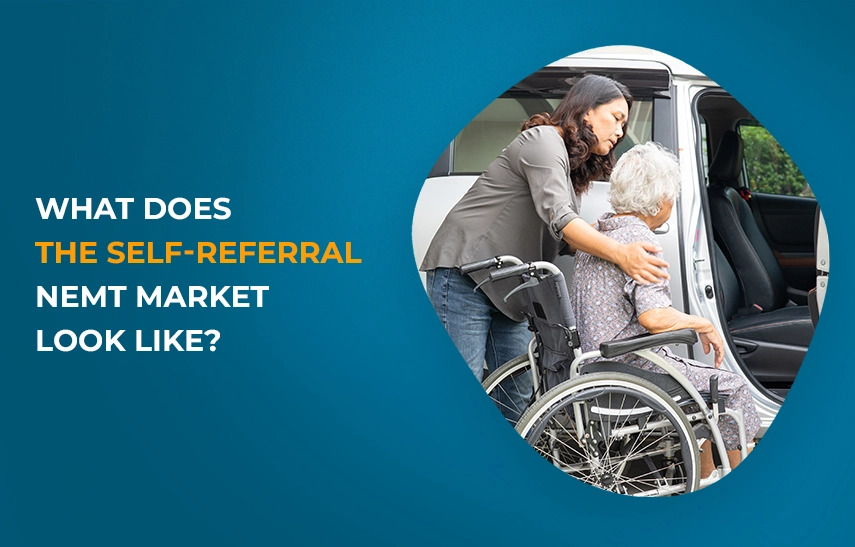What is Self-Referral in NEMT?

Self-referral in non-emergency medical transport (NEMT) is when passengers or their caregivers directly make arrangements for your transportation services. This is in contrast to cases where healthcare facilities and other similar organizations contact your NEMT company on behalf of their patients.
Self-referrals offer several benefits to your customers and your company. They are a valuable business opportunity. Many passengers who book directly tend to require frequent NEMT services. Hence, self-referral in NEMT has the potential to become a significant market and a steady revenue source for your company.
To fully capitalize on this opportunity, you need to more fully understand what self-referrals are, the Medicaid guidelines concerning them, and other relevant information.
By the end of this article, you’ll feel more confident and equipped to include self-referrals in your operational and marketing strategies. Let’s begin.
Contents:
- What is Self-Referral in Healthcare and Who Pays for It?
- What Does the Self-Referral NEMT Market Look Like?
- Medicaid Guidelines for NEMT Self-Referrals
- How NEMT Companies Benefit from Self-Referrals
- Conclusion
What is Self-Referral in Healthcare and Who Pays for It?
We already know that self-referral is the process where passengers independently seek transportation for their necessary (but not emergent) medical appointments. But who bears the cost? If the passenger is a Medicaid beneficiary, the state shoulders the expense. Other times, passengers pay out of pocket.
NEMT services are an excellent solution for passengers who may need:
- Adjustable, ergonomically designed seats
- Handrails
- Wheelchair lifts and ramps
- Ample passenger space to accommodate medical equipment
What Does the Self-Referral NEMT Market Look Like?
 As you begin catering to self-referrals, you’ll notice certain shared traits in the passengers you serve. These are some of the passengers you’ll commonly encounter:
As you begin catering to self-referrals, you’ll notice certain shared traits in the passengers you serve. These are some of the passengers you’ll commonly encounter:
- Patients who attend routine medical appointments find it convenient to book NEMT services. They may have chronic conditions that need to be regularly checked by medical professionals.
- Admitted patients who have been discharged from the hospital usually need NEMT. Your NEMT vehicles can transport them back home or move them to a rehabilitation facility.
- Patients who need regular treatments, such as physical therapy or dialysis, often prefer the flexibility and additional assistance that an NEMT vehicle provides.
NEMT vehicles have some similarities to ambulances but they’re easier on the pocket. Ambulances in the United States cost an average from $940 to $1,277 while NEMT services cost $25 to $300 on average.
Self-referral gives patients greater convenience and control over their transportation needs. It simplifies and speeds up the process while improving access to transportation.
Medicaid Guidelines for NEMT Self-Referrals
One market you’ll want to consider is Medicaid beneficiaries. According to the Centers for Medicare & Medicaid Services (CMS), around three to four million beneficiaries relied on NEMT services annually from 2018 to 2021.
CMS is the federal agency handling Medicaid. It implements the following self-referral policies for NEMT companies:
You Need To Have a Contract
You must have a signed contract with your customer before providing NEMT services. Medicaid will not pay you if you don’t have a signed agreement.
Get the Necessary Authorizations
CMS refers to this requirement as “prior authorization.” It means that you need to receive the necessary authorizations based on your state’s guidelines.
The authorizations you need vary by state. Some states require authorizations from physicians. Others ask you to verify that the drop-off location was a medical facility. States may also require you to receive a transportation request from a medical facility before transporting a passenger.
Check the guidelines in the state where you operate.
Pay Attention To Your Loaded Mileage
Medicaid computes its payment based on account loaded mileage, wait times, and location. Loaded mileage refers to the amount of time that a Medicaid beneficiary spends inside your NEMT vehicle.
Note that if a passenger doesn’t show up for a booked ride, Medicaid will not pay for your services.
Only Medical-Related Trips Are Covered
This may seem like an obvious guideline but enough people have tried using NEMTs for non-medical reasons that CMS specifically mentioned as a rule.
Passengers may ask you to drop them off at a supermarket, even if they’ve come from a medical appointment. Explain Medicaid rules to them and drop them off at home. Your trips should be from the home to the medical facility and home again.
If they’re meeting friends, going shopping, eating at a restaurant, or something similar and you agree to take them somewhere else, you won’t get paid.
You Won’t Get Paid More for Extended Waiting Times
Most states won’t pay you more if you have to spend extra time waiting for a passenger. However, it’s possible that the state has already factored in the wait times in its transportation payment rates.
States and managing entities also have mandatory wait times that are worth checking.
Additionally, Medicaid may impose state-sanctioned criteria for NEMT drivers. It can also ask for maintenance and documentation requirements for NEMT vehicles.
You can learn more about partnering with Medicaid through this online booklet.
How NEMT Companies Benefit from Self-Referrals
 Passengers benefit from booking rides directly with NEMT providers but the system also has several advantages for you.
Passengers benefit from booking rides directly with NEMT providers but the system also has several advantages for you.
More Business Opportunities
You could enjoy more requests for transport while broadening your customer base. As mentioned, many individuals require regular and frequent medical visits which can be profitable for your business.
Streamlined Operations
The opposite of self-referrals, provider referrals, requires coordination with several healthcare organizations. As you can imagine, this is more complicated, demanding, and expensive on your end because your staff needs to exert more time and effort on these types of transactions.
Self-referrals, in contrast, require less administrative work. Since you’re coordinating directly with the person who needs your services, finalizing them is faster, simpler, and easier.
To further streamline operations, consider all-in-one NEMT software by RouteGenie. Our modern solution handles and automates daily tasks like billing, routing, schedules, and dispatching.
Higher Customer Satisfaction
The autonomy and convenience offered by self-referral can elevate the customer experience and boost customer satisfaction. As long as you ensure a positive working relationship with your passengers, you can build your company’s reputation and customer base with referrals and repeat business.
Enhanced Responsiveness and Flexibility
Since you’re doing away with intermediaries, you can offer greater flexibility and responsiveness. You can more easily respond to urgent and last-minute requests, giving you a competitive advantage.
Conclusion
Self-referrals offer you opportunities to expand your market and cater to more passengers. It’s an easy way to grow your business with services and equipment you already have.
If you’re thinking of accepting passengers who rely on Medicaid, carefully review the program’s policies and requirements to determine if it is a good fit for your NEMT company
About the author
An experienced content writer, Keren Dinkin’s forte is writing well-informed medical transportation, healthcare accounting, and related articles. Her work is backed by months of intensive research and pays meticulous attention to details. In addition to being a writer, she also dons the hat of a content strategist.
The author assumes no responsibility or liability for any errors or omissions in the content of this site. The information contained in this site is provided on an "as is" basis with no guarantees of completeness, accuracy, usefulness or timeliness.